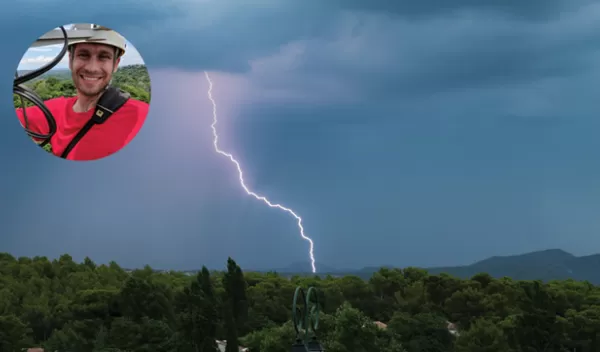
In the tropics, woody vines make lightning more deadly for forests
Many tropical forests are experiencing increases in lightning and lianas, thanks in part to global change. This one-two punch is likely causing an increase in the death of small trees, which could lead to shifts in composition of tropical forests and their ability to store carbon. So reports a U.S. National Science Foundation-supported paper in the journal New Phytologist.
"Ecological disturbances are increasing as a result of climate change," says Matt Kane, a program director in NSF's Division of Environmental Biology. "Knowing the short- and long-term effects of lightning strikes is helping improve scientific understanding and sustainability of tropical forest ecosystems."
Tropical forests experience 35-67 million lightning strikes each year, and strikes appear to be more frequent. Evan Gora, the paper's lead author and a scientist at the Cary Institute of Ecosystem Studies, says that "lightning is a major cause of tree death and forest disturbance, yet it has been understudied as an agent of change. We wanted to understand why some lightning strikes kill more trees than others — and discovered that lianas play an outsized role."
Lianas are woody vines with long climbing stems that are common in the tropics. In competition for sunlight, lianas grow up trees and into their canopies. Gora and colleagues found that liana density is positively associated with the number of trees killed and damaged by lightning. The team's research indicates that this is because lianas — which are highly conductive — serve as a pathway for electrical current to move from large to small trees.
"Large trees are more likely to be struck by lightning," Gora says. "When lianas are in the canopy, they amplify the effects of lightning strikes, resulting in more severe damage to neighboring trees. By physically connecting trees that would otherwise be separated, lianas act like jumper cables, delivering deadly electrical current to smaller understory trees that would otherwise survive a lightning strike."
The research took place in a lowland forest on Barro Colorado Island, Panama, the only tropical forest where lightning impacts have been systematically quantified. Here, it is estimated that lightning kills more than 16% of tree biomass annually, including 40-50% of the largest trees.
A novel lightning detection system was used to reveal the mechanisms underlying this variation and whether the presence of lianas influenced the severity of lightning disturbance. Surveys were conducted on 78 lightning strikes located in areas where lianas have been mapped; 1,921 trees with conspicuous lightning damage were monitored. Tree condition was evaluated within four months of the lightning strike and up to four times within 23 months post-strike.
